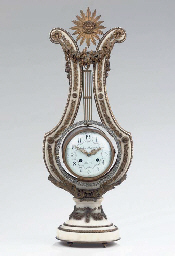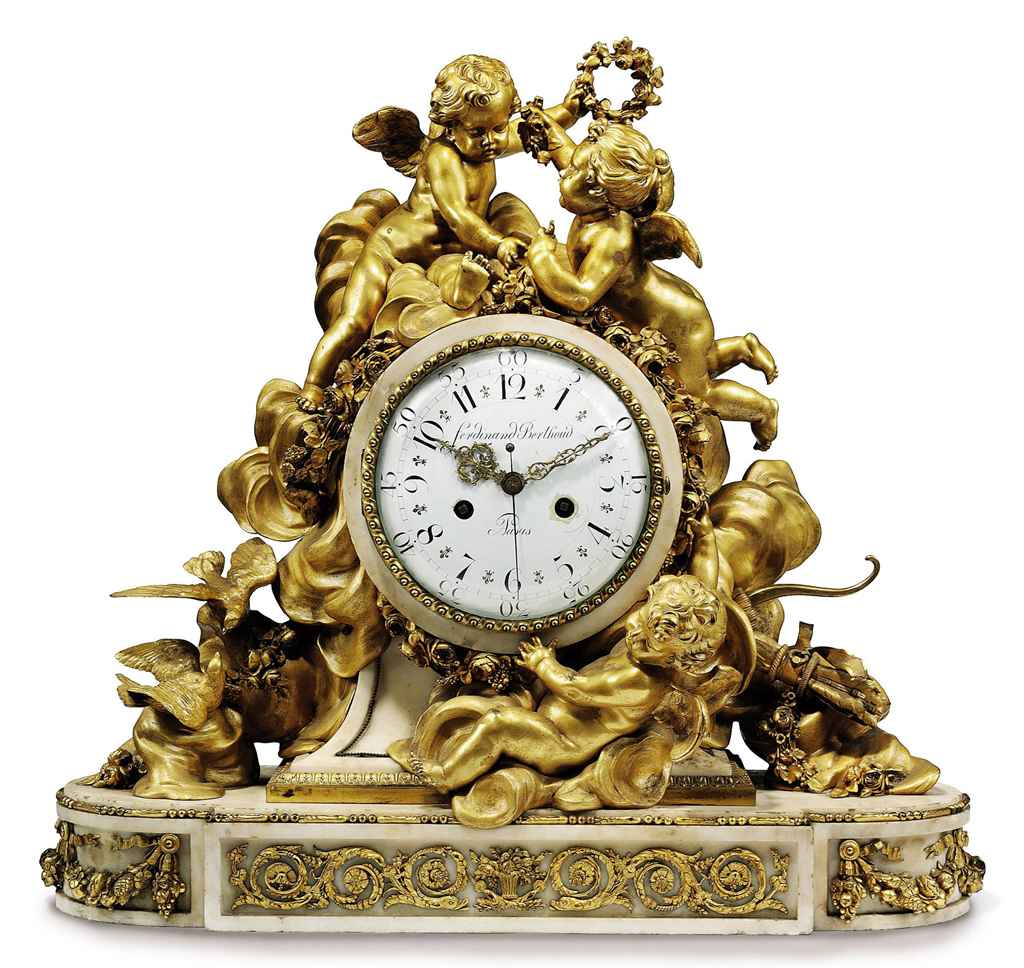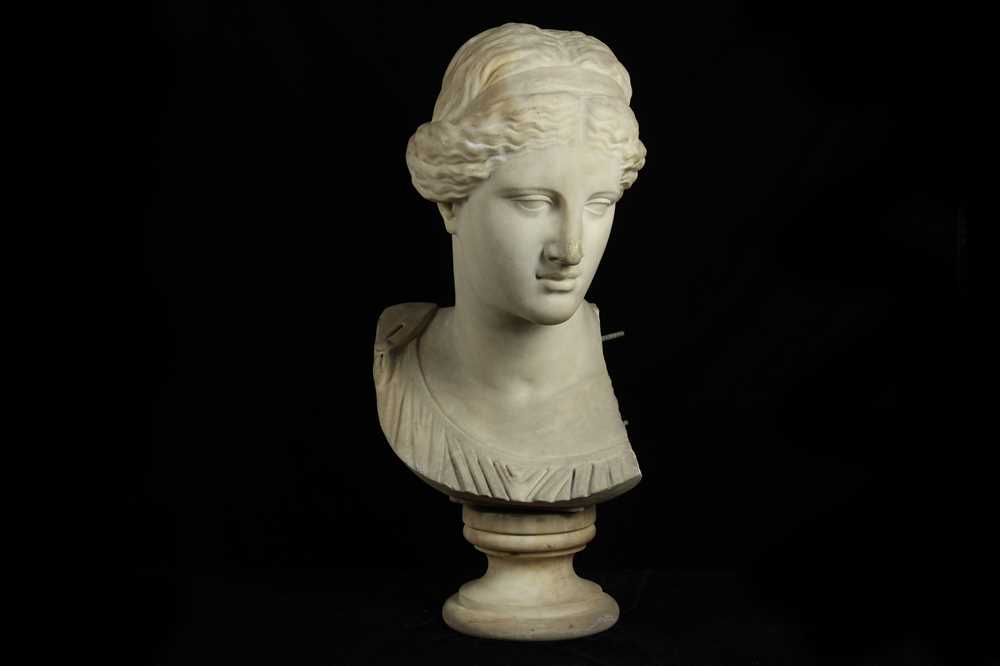China, 550-577. The slender figure standing in a serene pose and modeled in a gently rounded form, wearing an elegant long flowing robe leaving the chest bare and draped with thin scarves. A long, beaded necklace draping down from either shoulder to interlink through a ring at the waist and then falling along each leg. The softly modeled face with heavy-lidded downcast eyes below gently arched eyebrows and full lips pursed to form a subtle smile, the pleated hair secured by a diadem. Provenance: A prominent private collection in Versailles, France, by repute acquired at Parke-Bernet Galleries in New York and thence by descent in the same family to the last owner. Condition: Excellent condition, commensurate with age. Wear, weathering, structural cracks, losses and chips. Very few and minimal touchups. Authentic and naturally grown sedimentary encrustations, which sit tightly and cannot be removed. The failure envelope of the various losses is generally consistent with what would be expected of an archeological find from the region and period. The head, however, was broken off at some point during or after the excavation, and subsequently reattached. The marble with an unctuous, variegating creamy-white to russet patina. Weight: 46.9 kg (incl. base) Dimensions: Height 90 cm (excl. base) and 98 cm (incl. base) Mounted to an associated metal base. (2) This delicately carved marble figure is remarkable for its crisp lines that capture the elegant characteristic of the sculpture of the Northern Qi dynasty. The sense of ethereal grace of Avalokiteshvara is heightened by the subtly carved layers of minimalist robes and by the simple yet elegant ornaments decorating the figure. According to Osvald Siren in ‘Chinese Marble Sculptures of the Transition Period’, Bulletin of the Museum of Far Eastern Antiquities, no. 12, Stockholm, 1940, pp. 473-96, marble figures carved in this specific and distinct style, where the figure is modeled in a gently rounded form with the details worked in low-relief carving, were made for only a short period in the second half of the sixth century. Buddhism flourished during the Northern Qi dynasty, which saw a great increase in the production of statues and a proliferation of styles. The Qi aristocracy, headed by a military class of nomadic origin, was not only hostile to Chinese influence, but it also had a predilection for the foreign and exotic, especially in art. Hence, a style influenced by the Gupta art of India acquired pre-eminence soon after the Northern Qi dynasty came to power. Northern Qi figures are generally clad in thin, clinging robes, with an emphasis on portraying the solidity of the body rather than decorative drapery, which was characteristic of figures during the preceding Wei dynasty. This emphasis on the body went hand in hand with increased three-dimensionality. Thus, while Wei dynasty Buddhist figures form a relief with their body nimbuses, Northern Qi sculptures often stand free of their backgrounds. Auction result comparison: Compare a closely related marble figure of a bodhisattva, but of considerably smaller size (57 cm high), at Sotheby’s New York in Fine Chinese Ceramics & Works of Art on 16 September 2008, lot 168, bought-in at an estimate of USD 80,000-120,000. Compare also a closely related but much smaller (32.5 cm high) marble figure of Avalokiteshvara, but in better condition than the present lot, at Sotheby’s Hong Kong in Chinese Art Through the Eye of Sakamoto Goro on 8 October 2013, lot 133, sold for HKD 750,000, and a closely related gray marble torso of related size, dated ca. 570-590, at Christie’s New York in Fine Chinese Ceramics and Works of Art on 20 September 2013, lot 1509, sold for USD 62,500. 北齊大型漢白玉觀音立像 中國,550-577年。觀音身形修長端莊,身軀略顯清瘦,兩肩削圓,胸口平實,胸前掛有項鍊,身披天衣和瓔珞,瓔珞於腹部交叉成X形,穿著長裙,裙帶繫紥於腰際。頭上戴冠,臉型長圓,兩頰豐腴柔軟,眉毛以弧形陰線刻劃,兩眼下視,可見眼內瞳仁,鼻樑略寬,兩翼飽滿,嘴部雕琢細膩,展現出微妙的笑容。 來源:法國凡爾賽一知名私人收藏,據説購於紐約 Parke-Bernet Galleries 藝廊,保存在同一家族直至最後一位持有者。 品相:狀況極佳,與年齡相稱。 磨損、風化、結構裂縫、缺損和碎屑。極少的修整。自然產生的結殼,緊
China, 550-577. The slender figure standing in a serene pose and modeled in a gently rounded form, wearing an elegant long flowing robe leaving the chest bare and draped with thin scarves. A long, beaded necklace draping down from either shoulder to interlink through a ring at the waist and then falling along each leg. The softly modeled face with heavy-lidded downcast eyes below gently arched eyebrows and full lips pursed to form a subtle smile, the pleated hair secured by a diadem. Provenance: A prominent private collection in Versailles, France, by repute acquired at Parke-Bernet Galleries in New York and thence by descent in the same family to the last owner. Condition: Excellent condition, commensurate with age. Wear, weathering, structural cracks, losses and chips. Very few and minimal touchups. Authentic and naturally grown sedimentary encrustations, which sit tightly and cannot be removed. The failure envelope of the various losses is generally consistent with what would be expected of an archeological find from the region and period. The head, however, was broken off at some point during or after the excavation, and subsequently reattached. The marble with an unctuous, variegating creamy-white to russet patina. Weight: 46.9 kg (incl. base) Dimensions: Height 90 cm (excl. base) and 98 cm (incl. base) Mounted to an associated metal base. (2) This delicately carved marble figure is remarkable for its crisp lines that capture the elegant characteristic of the sculpture of the Northern Qi dynasty. The sense of ethereal grace of Avalokiteshvara is heightened by the subtly carved layers of minimalist robes and by the simple yet elegant ornaments decorating the figure. According to Osvald Siren in ‘Chinese Marble Sculptures of the Transition Period’, Bulletin of the Museum of Far Eastern Antiquities, no. 12, Stockholm, 1940, pp. 473-96, marble figures carved in this specific and distinct style, where the figure is modeled in a gently rounded form with the details worked in low-relief carving, were made for only a short period in the second half of the sixth century. Buddhism flourished during the Northern Qi dynasty, which saw a great increase in the production of statues and a proliferation of styles. The Qi aristocracy, headed by a military class of nomadic origin, was not only hostile to Chinese influence, but it also had a predilection for the foreign and exotic, especially in art. Hence, a style influenced by the Gupta art of India acquired pre-eminence soon after the Northern Qi dynasty came to power. Northern Qi figures are generally clad in thin, clinging robes, with an emphasis on portraying the solidity of the body rather than decorative drapery, which was characteristic of figures during the preceding Wei dynasty. This emphasis on the body went hand in hand with increased three-dimensionality. Thus, while Wei dynasty Buddhist figures form a relief with their body nimbuses, Northern Qi sculptures often stand free of their backgrounds. Auction result comparison: Compare a closely related marble figure of a bodhisattva, but of considerably smaller size (57 cm high), at Sotheby’s New York in Fine Chinese Ceramics & Works of Art on 16 September 2008, lot 168, bought-in at an estimate of USD 80,000-120,000. Compare also a closely related but much smaller (32.5 cm high) marble figure of Avalokiteshvara, but in better condition than the present lot, at Sotheby’s Hong Kong in Chinese Art Through the Eye of Sakamoto Goro on 8 October 2013, lot 133, sold for HKD 750,000, and a closely related gray marble torso of related size, dated ca. 570-590, at Christie’s New York in Fine Chinese Ceramics and Works of Art on 20 September 2013, lot 1509, sold for USD 62,500. 北齊大型漢白玉觀音立像 中國,550-577年。觀音身形修長端莊,身軀略顯清瘦,兩肩削圓,胸口平實,胸前掛有項鍊,身披天衣和瓔珞,瓔珞於腹部交叉成X形,穿著長裙,裙帶繫紥於腰際。頭上戴冠,臉型長圓,兩頰豐腴柔軟,眉毛以弧形陰線刻劃,兩眼下視,可見眼內瞳仁,鼻樑略寬,兩翼飽滿,嘴部雕琢細膩,展現出微妙的笑容。 來源:法國凡爾賽一知名私人收藏,據説購於紐約 Parke-Bernet Galleries 藝廊,保存在同一家族直至最後一位持有者。 品相:狀況極佳,與年齡相稱。 磨損、風化、結構裂縫、缺損和碎屑。極少的修整。自然產生的結殼,緊














Try LotSearch and its premium features for 7 days - without any costs!
Be notified automatically about new items in upcoming auctions.
Create an alert